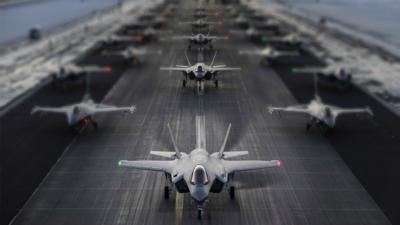No Actual Dollar-Figures Provided
Trillion: the term is tossed about Capitol Hill like a frisbee across a college campus’s quad; but it oughtn't be. One-trillion-seconds equals 31,689 years.

The U.S. federal deficit—the money owned by the United States Federal Government to its creditors—stands at $30.3-trillion. Paying back that amount at one-dollar-per-second would take 960,177-years. As a matter of reference, 960,177-years-ago, Homo erectus was fashioning stone tools with which to hunt wooly mammoths and fight off saber-tooth tigers, and marveling at fire—over which he’d only just gained control.
The F-35 Program is projected to cost U.S. taxpayers $1.7-trillion—a number of seconds equal to a scant 31,689 years. And the news gets better.
Lockheed Martin and the Pentagon have triumphantly announced they’re succeeding in driving down the F-35’s eye-watering and much-criticized sustainment costs. Naturally, neither Lockheed nor the Pentagon’s F-35 Joint Program Office disclosed any actual dollar-amounts, but they did assure American taxpayers that the average, annual, per-aircraft cost of operating the U.S. Air Force’s, Navy’s, and Marine Corps’ F-35s fell between 2020 and 2021.
To operate a single one of its F-35As throughout 2020, the United States Air Force shelled-out an average of $7.8-million—nearly double the service’s target of $4.1-million. Over the same time period, the U.S. Marine Corps paid $9.1-million per-plane to operate its F-35Bs, and $7.9-million to fly its F-35Cs—well over the $6.8-million target the Corps set for both planes. Not to be outdone by its Air Force or Marine brethren, the U.S. Navy operated its fleet of F-35Bs at a handsome, per-airplane annual rate of $9.9-million—surpassing its $7.5-million target by a cool $2.4-million.
Whatever the F-35’s ostensibly lower 2021 costs are, Lockheed claims the diminishment was achieved in part by keeping components on the jets longer. Lockheed Martin vice president of F-35 sustainment Audrey Brady maintains that more than 90% of F-35 parts are staying on the jets longer than predicted. Whether or not Ms. Brady’s assertion speaks to lax maintenance practices or poor predictive models is unknown. “Increasing the mean flight hour between failure is absolutely a game changer,” Brady stated—somewhat obviously.

During a 31 August 2022 briefing, Lockheed Martin made public that its own share of the F-35′s annual cost per tail—a metric the Air Force prefers over cost per flying hour—dropped 37% between 2015 and 2021, and that the F-35’s fleet-wide cost-per-flying-hour dropped fifty-percent over that period. The aerospace giant states it expects its share of the F-35 program’s costs to continue decreasing. Lockheed provided no exact dollar figures—describing such as “sensitive proprietary data”—but conceded it collects about forty-percent of the F-35 program nut.
Also revealed during the August briefing was a worrying statistic pertaining to the F-35’s reliability. Per Lockheed Martin data, newer F-35s typically fly only 14-hours between grounding failures. Remarkably, Lockheed shone a positive light on the number, contrasting it to the four to six flight hours early F-35s logged between failures. Lockheed ascribed the F-35’s increased reliability to the maturation of the design and production processes.
To date, Lockheed Martin has delivered upward of 825 F-35s to the militaries of 15 nations, and the company expects that number to nearly double over the next five-years.
 Aero-TV: DeltaHawks Diesel Power Steps Into the Spotlight
Aero-TV: DeltaHawks Diesel Power Steps Into the Spotlight NTSB Prelim: Mooney Aircraft Corp. M20K
NTSB Prelim: Mooney Aircraft Corp. M20K ANN FAQ: Turn On Post Notifications
ANN FAQ: Turn On Post Notifications ANN's Daily Aero-Linx (12.20.25)
ANN's Daily Aero-Linx (12.20.25) Aero-News: Quote of the Day (12.20.25)
Aero-News: Quote of the Day (12.20.25)




